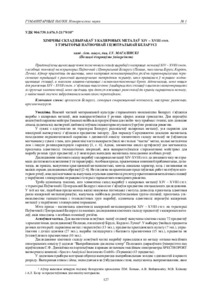Please use this identifier to cite or link to this item:
https://elib.psu.by/handle/123456789/27132Full metadata record
| DC Field | Value | Language |
|---|---|---|
| dc.contributor.author | Магалінскі, І. У. | - |
| dc.contributor.author | Mahalinski, I. | - |
| dc.date.accessioned | 2021-04-12T11:40:38Z | - |
| dc.date.available | 2021-04-12T11:40:38Z | - |
| dc.date.issued | 2021 | - |
| dc.identifier.citation | Магалінскі, І. В. Хімічны склад вырабаў з каляровых металаў XIV – XVIII стст. з тэрыторыі Паўночнай і Цэнтральнай Беларусі / І. В. Магалінскі // Вестник Полоцкого государственного университета. Серия A, Гуманитарные науки. - 2021. - № 1. - С. 127-130. | ru_RU |
| dc.identifier.issn | 2070-1608 | - |
| dc.identifier.uri | https://elib.psu.by/handle/123456789/27132 | - |
| dc.description.abstract | Прадстаўлены вынікі вывучэння элементнага складу вырабаў з каляровых металаў XIV – XVIII стст. з асобных помнікаў на тэрыторыі Паўночнай і Цэнтральнай Беларусі (Полацк, паселішчы Бірулі, Кардон, Лучна). Аўтар прыходзіць да высновы, што каляровая металаапрацоўка рэгіёна характарызуецца пераемнасцю традыцый з рамеснай вытворчасцю папярэдняга перыяду, што праявілася ў перавазе медна-цынкавых сплаваў, а таксама алавяна-свінцовых і шматкампанентных бронз. Адзначаецца, што новым для рамяства XIV – XVIII стст. з’яўляецца павелічэнне ў выбарцы долі сплаваў з высокімі канцэнтрацыямі легіруючых кампанентаў, што сведчыць пра доступ мясцовых рамеснікаў да крыніц сыравіннага металу, у найменшай ступені забруджанага шматлікімі пераплаўкамі.= The article presents the results of studying the elemental composition of products made from non-ferrous metals of the XIV – XVIII centuries from certain memorials in the territory of Northern and Central Belarus (Polotsk, the villages of Biruli, Kardon and Luchno). The author concludes that processing of non-ferrous metals in the region is characterized by continuity of traditions of the craft of the previous period which is manifested in the predominance of copper-zinc alloys, as well as tin-lead and multicomponent bronzes. It is noted that a distinctive feature of the craft of the XIV – XVIII centuries is the increase in the sample of alloys with high concentrations of alloying components, which indicates that local artisans had an access to sources of raw metal minimally contaminated by multiple remelting. | ru_RU |
| dc.language.iso | be | ru_RU |
| dc.publisher | Полоцкий государственный университет | ru_RU |
| dc.relation.ispartof | Веснік Полацкага дзяржаўнага ўніверсітэта. Серыя А, Гуманітарныя навук | be_BE |
| dc.relation.ispartof | Herald of Polotsk State University Series A, Humanity sciences | en_EN |
| dc.relation.ispartof | Вестник Полоцкого государственного университета. Серия A, Гуманитарные науки | ru_RU |
| dc.relation.ispartofseries | Серия A, Гуманитарные науки;2021. - № 1 | - |
| dc.rights | open access | ru_RU |
| dc.subject | Государственный рубрикатор НТИ - ВИНИТИ::ОБЩЕСТВЕННЫЕ НАУКИ::История. Исторические науки | ru_RU |
| dc.subject | Археалогія Беларусі | ru_RU |
| dc.subject | Гісторыя старажытнай тэхналогіі | ru_RU |
| dc.subject | Ювелірнае рамяство | ru_RU |
| dc.subject | Археаметалургія | ru_RU |
| dc.subject | Archeology of Belarus | ru_RU |
| dc.subject | History of ancient technology | ru_RU |
| dc.subject | Jewelry art | ru_RU |
| dc.subject | Archaeometallurgy | ru_RU |
| dc.title | Хімічны склад вырабаў з каляровых металаў XIV – XVIII стст. з тэрыторыі Паўночнай і Цэнтральнай Беларусі | ru_RU |
| dc.title.alternative | Chemical Composition of Products Made From Non-Ferrous Metals of the XIV – XVIII Centuries in the Terrirory of Northern and Central Belarus | ru_RU |
| dc.type | Article | ru_RU |
| dc.identifier.udc | 904:739.1(476.5-21)”9/10” | - |
| Appears in Collections: | 2021, № 1 | |
Files in This Item:
| File | Description | Size | Format | |
|---|---|---|---|---|
| 127-130.pdf | 373.69 kB | Adobe PDF |  View/Open |
Items in DSpace are protected by copyright, with all rights reserved, unless otherwise indicated.